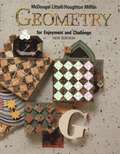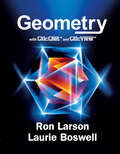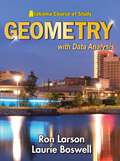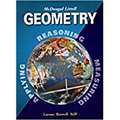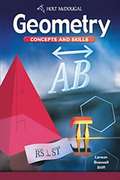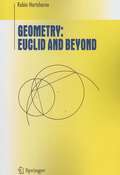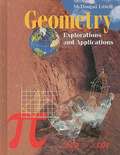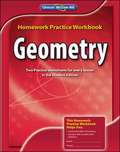- Table View
- List View
Geometry Texas: Interactive Student Edition (Volume #2)
by Timothy D. Kanold Edward B. Burger Juli K. DixonVolume 2 of the first edition of this geometry textbook for students.
Geometry for Enjoyment and Challenge (New Edition)
by Robert Whipple George Milauskas Richard RhoadGeometry for Enjoyment and Challenge has been authored to make geometry fun, exciting, and powerful.
Geometry, Florida
by Randall I. Charles Basia Hall Dan Kennedy Grant Wiggins Art Johnson Laurie E. Bass Stuart J. MurphyNIMAC-sourced textbook
Geometry, Student Text and Homework Helper
by Randall I. Charles Allan E. Bellman Basia HallNIMAC-sourced textbook
Geometry: Applying, Reasoning, Measuring (Mcdougal Littell High School Math Ser.)
by Ron Larson Laurie BoswellGeometry, like much of mathematics and science, developed when people began recognizing and describing patterns. In this course, you will study many amazing patterns that were discovered by people throughout history and all around the world. You will also learn to recognize and describe patterns of your own. Sometimes, patterns allow you to make accurate predictions.
Geometry: Common Core
by Randall I. Charles Basia Hall Dan Kennedy Grant Wiggins Art Johnson Laurie E. Bass Stuart J. MurphyNIMAC-sourced textbook
Geometry: Concepts and Skills
by Ron Larson Laurie Boswell Lee StiffGeometry: Concepts and Skills has been written so that all students can understand geometry. The course focuses on the key topics that provide a strong foundation in the essentials of geometry. Lesson concepts are presented in a clear, straightforward manner, supported by frequent worked-out examples. The page format makes it easy for students to follow the flow of a lesson, and the vocabulary and visual tips in the margins help students learn how to read the text and diagrams. Checkpoint questions within lessons give students a way to check their understanding as they go along. The exercises for each lesson provide many opportunities to practice and maintain skills, as well as to apply concepts to real-world problems.
Geometry: Concepts and Skills (South Carolina)
by Ron Larson Laurie Boswell Lee StiffNIMAC-sourced textbook
Geometry: Euclid And Beyond (Undergraduate Texts In Mathematics)
by Robin HartshorneIn recent years, I have been teaching a junior-senior-level course on the classi cal geometries. This book has grown out of that teaching experience. I assume only high-school geometry and some abstract algebra. The course begins in Chapter 1 with a critical examination of Euclid's Elements. Students are expected to read concurrently Books I-IV of Euclid's text, which must be obtained sepa rately. The remainder of the book is an exploration of questions that arise natu rally from this reading, together with their modern answers. To shore up the foundations we use Hilbert's axioms. The Cartesian plane over a field provides an analytic model of the theory, and conversely, we see that one can introduce coordinates into an abstract geometry. The theory of area is analyzed by cutting figures into triangles. The algebra of field extensions provides a method for deciding which geometrical constructions are possible. The investigation of the parallel postulate leads to the various non-Euclidean geometries. And in the last chapter we provide what is missing from Euclid's treatment of the five Platonic solids in Book XIII of the Elements. For a one-semester course such as I teach, Chapters 1 and 2 form the core material, which takes six to eight weeks.
Geometry: Explorations and Applications
by Miriam A. Leiva Stuart J. Murphy Douglas B. Aichele Patrick W Hopfensperger Marguerite M. Mason Vicki J. Schell Matthias C. VheruThis book will help you use mathematics in your daily life and prepare you for success in future courses and careers.
Geometry: Homework Practice Workbook
by Glencoe Mcgraw-HillThe Homework Practice Workbook contains two worksheets for every lesson in the Student Edition. This workbook helps students: Practice the skills of the lesson, Use their skills to solve word problems.
Geometry: Integration - Applications - Connections
by Timothy D. Kanold Carol Malloy Robert Cummings Allan BereleThis textbook talks about real-world uses of geometry

